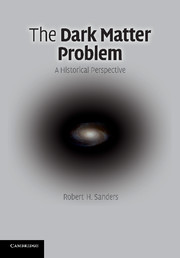Book contents
- Frontmatter
- Contents
- Acknowledgements
- 1 Introduction
- 2 Early history of the dark matter hypothesis
- 3 The stability of disk galaxies: the dark-halo solution
- 4 Direct evidence: extended rotation curves of spiral galaxies
- 5 The maximum-disk: light traces mass
- 6 Cosmology and the birth of astroparticle physics
- 7 Clusters revisited: missing mass found
- 8 CDM confronts galaxy rotation curves
- 9 The new cosmology: introducing dark energy
- 10 An alternative to dark matter: modified Newtonian dynamics
- 11 Seeing dark matter: the theory and practice of detection
- 12 Reflections: a personal point of view
- Appendix Astronomy made simple
- References
- Index
5 - The maximum-disk: light traces mass
Published online by Cambridge University Press: 05 July 2014
- Frontmatter
- Contents
- Acknowledgements
- 1 Introduction
- 2 Early history of the dark matter hypothesis
- 3 The stability of disk galaxies: the dark-halo solution
- 4 Direct evidence: extended rotation curves of spiral galaxies
- 5 The maximum-disk: light traces mass
- 6 Cosmology and the birth of astroparticle physics
- 7 Clusters revisited: missing mass found
- 8 CDM confronts galaxy rotation curves
- 9 The new cosmology: introducing dark energy
- 10 An alternative to dark matter: modified Newtonian dynamics
- 11 Seeing dark matter: the theory and practice of detection
- 12 Reflections: a personal point of view
- Appendix Astronomy made simple
- References
- Index
Summary
Reaction follows revolution
In the summer of 1982 Symposium number 100 of the International Astronomical Union took place in the French pre-alps, in the university town of Besançon. The subject of the symposium was the “Internal kinematics and dynamics of galaxies”. By this point, the existence of a discrepancy between the dynamical mass and the visible, or detectable mass of galaxies had become a generally accepted fact. This acceptance was based largely upon the observations of the extended and non-declining rotation curves of spiral galaxies. In particular, the optical rotation curves had played an extremely important role in this perception. Observations, primarily by Rubin and collaborators, in optical emission lines of the rotation curves of very large galaxies such as UGC 2885 (Fig. 4.12) were especially important in enforcing this perception, even though, by definition, optical rotation curves could not extend beyond the visible disk of the galaxy.
The commonly believed explanation for this discrepancy was that already provided by Ostriker and collaborators: that spiral galaxies are immersed in massive and extended dark halos, dark halos with a mass that only increases with scale. In the previous decade there had been considerable resistance to this view, but by the time of this IAU Symposium, it was well on the way to becoming the central paradigm of galaxy structure and dynamics. There were still, however, pockets of resistance to this point of view.
- Type
- Chapter
- Information
- The Dark Matter ProblemA Historical Perspective, pp. 57 - 68Publisher: Cambridge University PressPrint publication year: 2010



